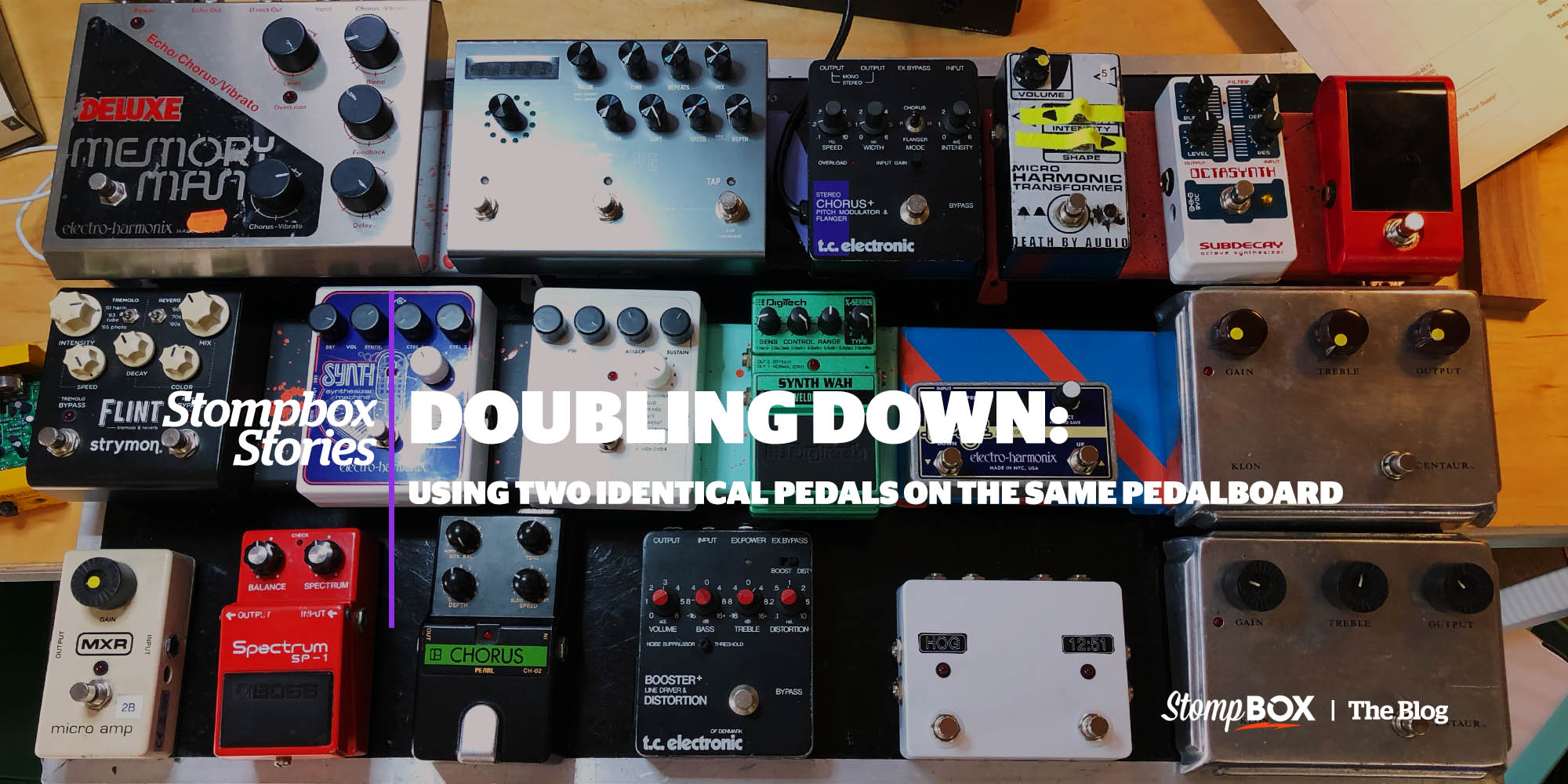Doubling Down: Using Two Identical Pedals on the Same Pedalboard
The first stompbox I ever owned was a DOD Distortion FX55, purchased from one of the stores along 48th Street – Manhattan’s legendary “Music Row” – in the mid-1980s. As the only guitarist in Voodoo Sex Party, my aptly-named college band, I needed something that would add a nice helping of hair to guitar solos boosted by the clean channel of my Peavey Bandit 65, and that grouchy little red box did the trick.
Still, I always wished I could get my guitar to roar like Johnny Ramone’s, especially since we played a lot of Ramones covers in our sets (and generally played other artists’ songs as if they were being covered by the Ramones). Of course, I couldn’t afford to have a stack of Marshalls like Johnny’s behind me… but the proverbial Eureka! light bulb went on over my head when I found out that a guitarist friend on campus also owned a FX55. If my guitar sounded good through one distortion pedal, I reasoned, two would surely sound awesome!
At the next Voodoo Sex Party gig, I chained my FX55 to my friend’s, firmly expecting a tidal wave of roaring distortion to come pouring out of my Peavey as soon as I kicked both pedals. Instead, I unleashed an untamable squall of shrieking feedback every time I tried to play a solo — which was kind of cool in itself, but decidedly not what I was going for. I quickly abandoned the experiment, figuring that further attempts to pair the pedals in series would surely lead to deafness, if not insanity.
With so many cool pedal choices out there, the idea of using two of the same units together never really crossed my mind again — and anyway, my one disastrous experience going down that road was enough to convince me that it was a lousy idea.
“In the end, if it’s good enough for Stevie Ray Vaughan, Dave Navarro, and Zachary Vex, clearly my original dual-pedal concept wasn’t so crazy after all…”
In more recent years, however, I’ve often used two dirt pedals together in the same chain. But they’ve always been ones with very different tones and textures, like a Vox Tonebender and an Electro-Harmonix Big Muff Pi, or a Catalinbread Formula No. 5 overdrive and an Earthquaker Hoof fuzz. In retrospect, though, maybe I should have spent a little more time with that double-FX55 experiment. Not that I would have eventually sounded like Johnny Ramone – few, if any, ever have; I might have at least been able to dial in a thicker yet still usable growl, if only I’d had the good sense not to crank both of them at full volume.
I thought of this when I recently interviewed the Rev. Billy F. Gibbons for Stompbox, and the discussion turned to the six-pack of Bixonic Expandoras that he often chains together for live gigs. How the hell does one get all six of them to play nicely together? I asked him. “Volume control,” he sagely replied. “Escalating as it goes.”
The good Reverend isn’t the first hotshot Texas guitarist to combine multiple identical effects units for a significant sonic payoff. The late, great Stevie Ray Vaughan was known to use two Ibanez Tube Screamers at the same time. By running one into the other, with the gain set low and the volume all the way up on both, he was able to achieve a beautifully fat, compressed lead tone with crazy sustain. SRV’s penchant for doubling effects pedals wasn’t limited to little green stompboxes, either; on “Say What?,” the wah-tastic opening track from 1985’s Soul to Soul, he chained two Vox wah-wahs together and played through them with the pedals rocked in opposite directions, in order to enhance some of their tastier frequencies.
Rage Against the Machine/Audioslave/Prophets of Rage bassist Tim Commerford is a dual-wah fan, as well, though he runs his two Bass Crybabys typically in parallel, rather than in series — one each for two different channels. Dave Navarro takes a similar approach with his beloved Boss DD-3 digital delays. In a recent interview with Stompbox, he told Matt Diehl that he uses one DD-3 for his distorted tones on things like the solo to “Mountain Song” and one for his clean rig, where it functions in more of an ambient, reverb-y sort of way.
But while running two of the same pedals in parallel on a two-rig setup is certainly a more manageable way of getting the sounds you’re after, there’s still something really cool about running a pair of identical stompboxes in series, with one driving the other. The folks at ZVEX Effects clearly thought so when they built their Super Duper 2-IN-1 pedal, which is basically two of their Super Hard-On boost pedals with a master volume knob that allows you to properly calibrate the distortion that erupts when both circuits are engaged.
In the end, if it’s good enough for Stevie Ray Vaughan, Dave Navarro, and Zachary Vex, clearly my original dual-pedal concept wasn’t so crazy after all…
Can any of you think of other players who have used two of the same effects on their pedalboards? Or stompboxes that utilize two similar circuits to create a “super” effect? If so, let us know in the comments section below!

1 Comment
Join the discussion and tell us your opinion.
[…] and Peter Holmström of The Dandy Warhols. We’ve also explored the advantages of using two identical pedals on the same pedalboard, and spotlighted our talented contributor Michael […]